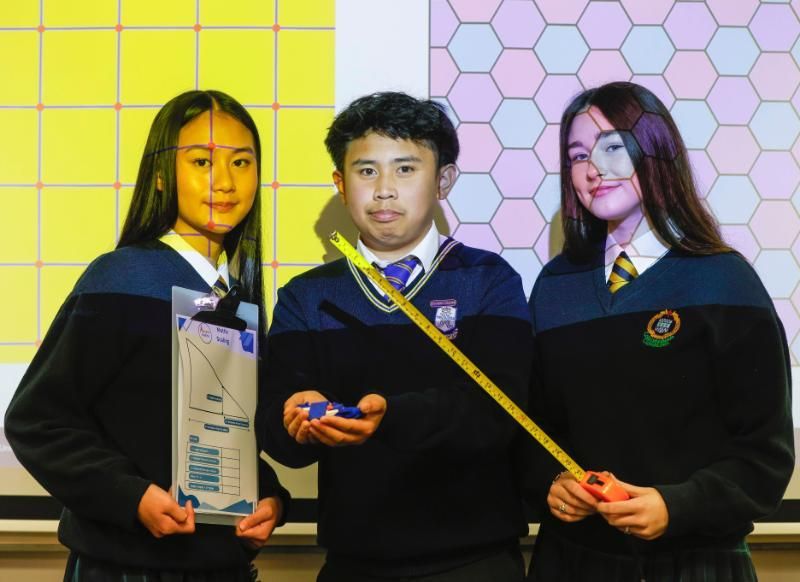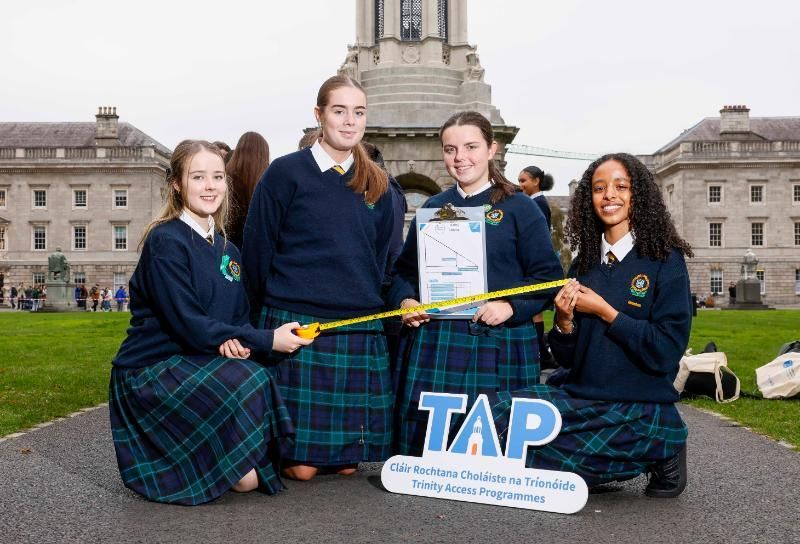Secondary students search for “ein Stein” in classic mathematics challenge
Posted on: 14 October 2025
Researchers from Trinity’s Experimental Mathematics Lab, partnering with staff in Trinity Access Programmes (TAP), welcomed 18 TY students from Coláiste Bríde and Marian College to take part in a classic “ein Stein” challenge as Maths Week takes centre stage in Ireland this week.
The students focused on “tessellations”, which have been used as building decorations and in mosaic art for millennia. Beyond their aesthetic appeal, tessellations also play a crucial role in modern science and engineering.
In materials science, for example, the study of tessellated structures helps researchers understand how patterns at the microscopic level can influence the strength and flexibility of materials, which is one of the reasons that mathematicians have devoted their efforts to the study of these fascinating objects. The tessellations we see in architecture are highly symmetric and if anyone wanted to come up with a tessellation it would be one with a high degree of symmetry.
But one long-burning question was: Are there tessellations whose patterns do not repeat?
A first so-called “aperiodic tiling” of the plane was achieved in the 1960s by Robert Berger. However, this construction required over 20,000 tile shapes. This number was steadily reduced over the years until Roger Penrose brought it down to only two pieces in the 1970s. These Penrose tilings would later be found in quasicrystals — a discovery that ultimately led to the 2011 Nobel Prize in Chemistry.
However, the main question remained: Is there an aperiodic tiling using only one piece? The quest for such a piece – humorously nicknamed “einstein” (from the German ein Stein, meaning “one stone”) – remained unsuccessful.
But this changed in November 2022 when hobbyist, David Smith, discovered an einstein now called “the hat” due to its shape.
In the Trinity event, the secondary students took a hands-on approach to this exciting story. Encoded as puzzles, they discovered how the Penrose tiling and the hat are patched together to tile the plane. They then explored how these constructions avoid repeating patterns, with the big takeaway being that anyone can make an exciting contribution to mathematics.
 Students from Coláiste Bríde and Marian College in Trinity.
Students from Coláiste Bríde and Marian College in Trinity.
This entire event grew out of the newly founded Experimental Mathematics Lab of Trinity’s School of Mathematics – an initiative in which undergraduate students, together with faculty, create visual, tangible mathematics, building an exhibition of mathematical objects.
Dr Marvin Anas Hahn, Assistant Professor in the School of Mathematics, said: “Mathematics shapes our daily lives, and nowadays more than ever. Let it be AI, social media algorithms or how GPS guides us on our travels. Yet despite this ubiquity of mathematics, many people, especially young schoolchildren, have a rather reserved relationship to this subject. It is perceived as dry, abstract and detached from real world experience.”
“This event aimed to change that perception by offering a fresh perspective — one where students could explore cutting-edge mathematics in a tangible, hands-on way.”
Dr Tommaso Cremaschi, also Assistant Professor in the School of Mathematics, added: “Engaging young people in mathematics is essential for nurturing curiosity, creativity, and problem-solving skills. Through exploring fascinating topics like tessellations, students can discover that mathematics is not just about numbers and formulas, but also about patterns, beauty, and design.
“Tessellations provide a perfect bridge between art and science, showing how geometry shapes both natural and human-made structures. By exploring these patterns, students gain insight into how mathematical thinking drives innovation in fields such as architecture, materials science, and chemistry. Most importantly, workshops like this aim to inspire young minds to see mathematics as a powerful tool for understanding and shaping the world around them.”
After that activity the students worked with TAP staff to apply some of their learning when considering the university campus through shapes and angles.

In groups, the students used themselves for scale to calculate the height of the Campanile using a measuring tape and basic maths formulas, before scaling images to make it appear as if they was the same size as the bell tower.
Media Contact:
Thomas Deane | Media Relations | deaneth@tcd.ie | +353 1 896 4685
